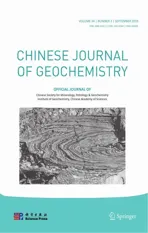Characteristics of biomarker in source rocks of Linxi Formation in Taohaiyingzi region,Zhalute basin
2015-01-17LiLiuYoujunTangXingchaoJiang
Li Liu•You-jun Tang•Xing-chao Jiang
Characteristics of biomarker in source rocks of Linxi Formation in Taohaiyingzi region,Zhalute basin
Li Liu1•You-jun Tang1•Xing-chao Jiang1
Based on gas chromatography and gas chromatography mass spectrometry techniques,the authors researched biomarker characteristics of the Linxi Formation source rocks in the area of Taohaiyingzi,and analyzed the information and petroleum geological signifcance that were indicated by source of organic matter,sedimentary environment,maturity and so on.Gas chromatography peak of saturated hydrocarbons from Linxi Formation source rocks showed‘‘the former peak’’of the single peak distribution and the C23-dominant main peak.This indicates that the main source of organic matter was mixed organic matter;Pr/Ph ratios ranged from 0.3 to 0.6,indicating a strongly reducing sedimentary environment. Molecular fossil assemblages in Linxi Formation source rocks were abundant in tricyclic terpane with long side chains,had high level of gammacerane,and showed dominant distribution of C27steranes.Gammacerane ratios range from 0.15 to 0.29,with an average of 0.19,implying that Linxi Formation hydrocarbon source rocks were formed in the environment of micro-saltwater water to half-saltwaterwater.Thehopanes/steranesratiosare mainly between 0.6 and 1.0,with an average of 0.84,implying that bacteria and algae had almost the samecontribution to organic matter.C27steranes abundance is high and the ratio of C27steranes/C29steranes is 1.13, showing that algae is the main source of hydrocarbon precursors.
Zhalute basin·Linxi formation· Hydrocarbon source rock·Biomarker
Biomarker or molecular fossils organic compounds in sedimentary organic matters and fossil fuels such as oil and coal whose chemical component carbon skeletons can be traced down to living organism with little or even no changes.Their stability can record special molecular structure of organic compounds,thus they can be linked directly to the special group of plants,animals or bacteria from which they originated(Peters and Moldowan 1993; Lu and Zhang 2008).Nowadays,because of it’s effectivity in practical exploration,it has been widely used to show the source of hydrocarbon precursors,imply the sedimentary environment,refect the maturity of organic matter and petroleum source correlation and reveal the secondary alteration degree of crude oil in reservoirs,especially in the research about samples collected from low explored outcrops(Tang and Chen 2011).
During the eleventh 5-year plan,China geology survey implemented the basic petroleum geology survey about upper paleozoic of Songliao Basin and its surrounding areas,clarifying that no regional metamorphism ever happened there except for some local regional metamorphism and thermodynamic metamorphism in different degrees (Zhang et al.2008).Through preliminary investigation, Linxi Formation source rocks is widely distributed among four sets source rocks there,which is high both in single layer and total layer thickness.In the following parts,it willbe revealed that Linxi Formation source rocks can be evaluated as medium-good source rocks referring to basic geochemistry parameters such as organic carbon,maturity, kerogen type and so on(Wang et al.2011).
The investigation of land and resources,which is taken on by Shenyang center of China geological survey,is named fundamental geology investigation of petroleum in the deep and peripheral of Songliao Basin.As you can see from the name,it aims at new areas and systems of Songliao peripheral places.The phase result has shown that dark mudstone of upper permian Linxi Formation deposited in semi-deep lake and shore-shallow lake and possibly transited from brackish water in earlier periods. The thick upper permian Linxi Formation black mudstone layer from outcrops around Zhalute Basin has high organic matter abundance,turning out to be good source rocks. Since analysis about characteristics of Linxi Formation source rocks are seldom reported from the perspective of biomarkers,gas chromatograpy and gas chromatography and mass spectrometry(GC–MS)analysises are conducted on Linxi Formation source rock samples to acquire biomarker distribution characteristics,hydrocarbon precursors,sedimentary environment and so on.
1 Samples and experiment
Samples are selected from Linxi Formation profle lying in Taohaiyingzi area,Zhalute Basin(Zheng et al.2013).The profle,850 meters long and 623.5 meters thick in true thickness,itis covered 224.55 meter-thickness by Quaternary system among total 322.0 meter-high sandstones.Dark mudstones has 16 layers in total,that is 19.27%in thickness,with overall thickness of 76.89 meters,among which the thickest one is 9.81 meters.21 shares of dark mudstone samples were picked up to gain chloroform extraction,separation of group compositions, saturated hydrocarbon chromatography–mass spectrometry and so on.Experiments conditions can be seen in references(Tang and Jianfa 2011).
2 Basic geochemistry characteristics
It is 21 shares of dark mudstones that were selected to be experiment samples whose TOC ranges from 0.70 to 1.10%,with an average of 0.88%(Fig.1),implying medium source rocks in organic matter abundance.The vitrinite refectance Ro(%)is between 1.3%and 1.7%,with a mean of 1.58%,revealing organic matter to be in the high matured thermal evolution stage(Fig.2).
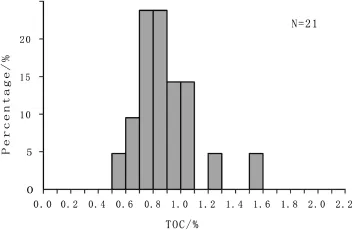
Fig.1 TOC histogram of hydrocarbon source rocks in Linxi Formation along Taohaiyingzi section

Fig.2 Ro histogram of hydrocaron source rocks in Linxi Formation along Taohaiyingzi section
2.1 N-alkanes and acyclic isoprenoid alkanes
N-alkanes exist extensively in bacterias,algaes and higher plants,thus it is closely related with organic matter precursors and maturity.Whereas Acyclic isoprenoid alkanes has various biological sources and formations.The normal acyclic isoprenoid alkanes whose carbonate number is no more than C20,mainly develop from phytol(Peters and Moldowan 1993;Beaumont and Foster 2002;Hou and Feng 2011).It can be seen from saturated hydrocarbon gas chromatography spectrometry(GC)(Fig.3)of classic samples from Linxi Formation that saturated hydrocarbon GC Pr/nC17and Ph/nC18scatter diagram indicates that organic matter source is mainly II1type(Fig.4).Pr/Phratios are between 0.3 and 0.6 with evident predominance of phytane,implying strongly reducing sedimentary environment.The peak is featured by single peak and main distribution of‘‘formal peak’’,with the main peak carbon to be C24and ΣnC21-/ΣnC22+from 0.2–0.5(Fig.5).Carbon predominance index(CPI)value and odd even predominance(OEP)is usually used to confrm whether N-alkanes have odd even predominance.The OEP is between 1.0 and 1.2.
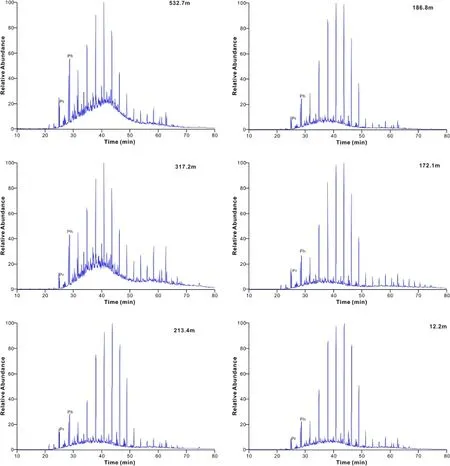
Fig.3 Saturated hydrocarbon gas chromatogram of source rocks in Linxi Formation along Taohaiyingzi section
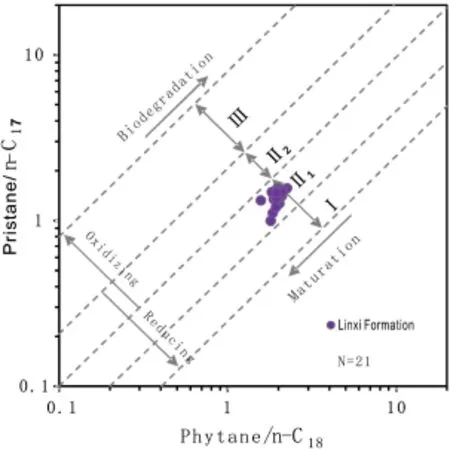
Fig.4 Pr/nC17and Ph/nC18correlogram of source rocks in Linxi Formation along Taohaiyingzi section

Fig.5 ΣnC21-/ΣnC22+distribution of source rocks in Linxi Formation along Taohaiyingzi section
2.2 Long-side-chain tricyclic terpanes and tetracyclic terpanes
Long-side-chain tricyclic terpanesmay derive from prokaryote whose tricyclic isoprehol or triterpanes can degraduate to long-side-chain tricyclic terpanes while tetracyclic terpanes are from the degradation of pentacyclic triterpanes in prokaryote which belongs to hopanoids (Peters and Moldowan 1993).In research area,abundant long-side-chain tricyclic terpanes,with carbon number between 19 and 30,is characterized by high content of C21triterpanes or C23triterpanes,and similar abundance between C24tetracyclic terpanes and C26tetracyclic terpanes indicating that organic matters orginate from bacterias (Fig.6).
2.3 Pentacyclic triterpane system
Pentacyclic triterpane can be divided into hopanoids and non-hopanoids.Hopanoids generally derive from prokaryote or bacteria whose precursors are more reasonably acknowledged to be bacteria hopanoid tetraol.Among nonhopanoids,gammercerane is dominant,thus it is an usual evaluation index of abnormal salinity and steady water delimitation along with recongnizing saltwater reducing environment.Gammercerane is widely distributed in carbonate rocks,crude oil from salt lake environment and sediments(Peters and Moldowan 1993;Zhang et al.1999).
The hopanoids,ranging from C31to C35(without C28), with the main peak to be 17 α(H),21β(H)-C30reduce successively in abundance from C31to C35(Fig.6).Tricyclic terpanes/pentacyclic hopanoids ratios range from 1.0 to 1.6,with an average of 1.31,showing that organic matter is high matured(Fig.7).However in non-hopanoids, medium abundance values is between 0.15 and 0.29,with the average of 0.19.As Gammerceranes abundance correlates closely with salinity of water,increasing with salinity, the abundance is very low in fresh water sediment(Zhang et al.1999).Based on Gammercerane distribution,organic matter would deposite in brackish water,therefore Linxi Formation is mainly fresh-water terrestrial deposition dominated by open-bog facies and is initially of transitional deposition(Li et al.2009).It can be analyzed from gammercerane distribution that Linxi Formation of Taohaiyingzi section is equivalent to those of Linxi area.
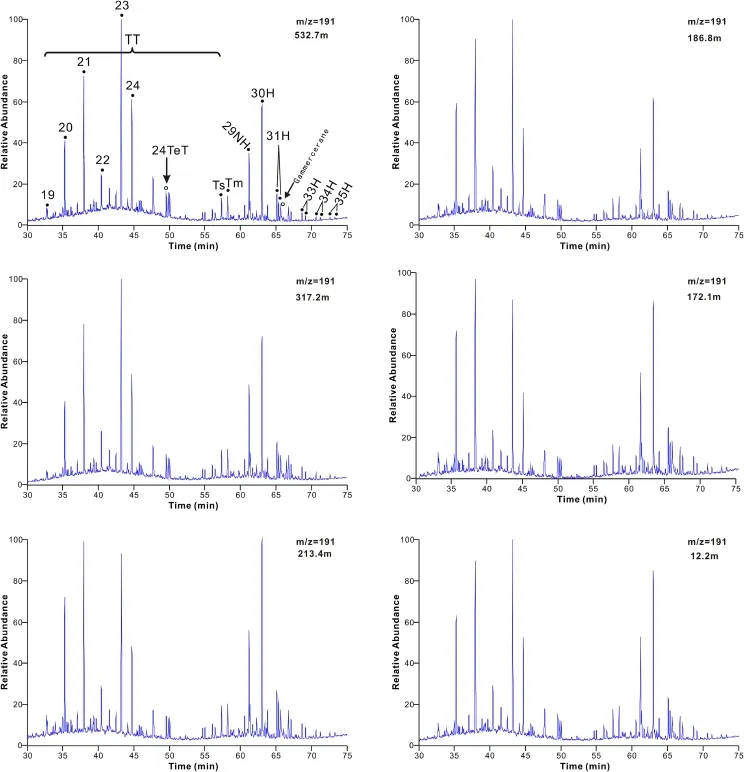
Fig.6 Termanes series distribution of source rocks in Linxi Formation along Taohaiyingzi section
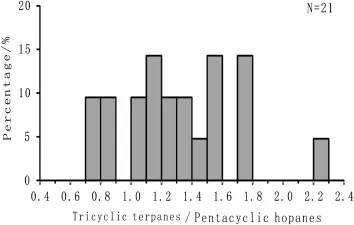
Fig.7 Tricyclic terpanes and pentacyclic hopane distribution of source rocks from Linxi Formation along Taohaiyingzi section
2.4 Steranes
Steranes is generally used to refect the contribution of eucaryon such as algae,phytoplankton and higher plants, whose carbon number distribution is in close connection with organic matter input,turning out to be an effective parameter of provenance(Peters and Moldowan 1993;Lu and Zhang 2008).Huang and Meinschein(Huang and Meinschein 1978)regarded that relative content of normal C27–C28–C29regular sternaes can be used to induce organic mater sedimentary source,among which C27sternanes originate from lower aquatic organism and higher plant respectively.The distribution of C27,C28,C29regular steranes show‘‘V’’pattern(Fig.8),namely C27steranes has higher content,indicating that the hydrocarbon generation material is mainly low aquatic organism.According to organic matter type chart board of C27,C28,C29steranes (ααα20 R)relaive contents,organic matter type can be judged to be type II from Fig.9.Hopanoids/steranes ratios can display relative contribution ofeucaryote and prokaryote to source rocks(Lu and Zhang 2008).As is observed in Fig.10,hopanoids/sternanes ratios are between 0.6 and 1.0,with a mean of 0.84,inducing that the bacteria and algae have almost the similar contribution to organic matter(Fig.10).
3 Conclusions
Advanced technologies were conducted to analyze biomaker characteristics of Linxi Formation source rocks in Taogaiyingzi area of Zhalute Basin,such as gas chromatography,gas chromatography—spectrometry,thus organic matter source,sedimentary environment,maturity are also revealed.Consequently,following cognitions are drawn.
(1) Molecular assemblages of Baishan Formation source rocks are characterized by abundant long-side-chain triterpanes and gammerceranes and C27steranes predominant distribution.
(2) Gammerceranes value of Linxi Formation source rocks is between 0.15 and 0.29,with a mean of 0.19, showing slight saline to half saline water environment.Pr/Ph ratios range from 0.3 to 0.6,indicating strongly reducing sedimentary environment.
(3) The gas chromatograms of saturated hydrocarbon from Linxi Formation source rocks is dominated by the single peak distribution of front peak.The main peak is C23.The correlation between Pr/nC17and Ph/ nC18show that the organic matter are mainly mixed. Hopanoid/steranes value ranges from 0.6 to 1.0,with an average of 0.84,showing bacteria and algae have the similar contribution to organic matter.Further more,C27steranes/C29steranes value is 1.13, namely higher abundance of C27steranes,revealing that hydrocarbon generation material source is mainly low aquatic organism.

Fig.8 Steranes series distribution of source rocks from Linxi Formation along Taohaiyingzi section

Fig.10 Steranes/hopanes distribution of source rocks from Linxi Formation along Taohaiyingzi section
Beaumont EA,Foster NH(2002)Exploration of hydrocarbon traps. Petroleum Industry Press,Beijing,pp 22–54(in Chinese)
Hou D,Feng Z(2011)Petroleum geochemistry.Petroleum Industry Press,Beijing,pp 201–242(in Chinese)
Huang WY,Meinschein WG(1978)Sterols are ecological indicators [J].Geoshimica et Cosmochim Acta 43:739–745
Li F,Qu X,Liu L(2009)Sedimentary Environment on upper permian linxi group in inner Mongolia. Acta Sedimentol Sin 27(2):265–272
Lu S,Zhang M(2008)Petroleum Geochemistry.Petroleum Industry Press,Beijing,pp 201–212(in Chinese)
Peters KE,Moldowan M(1993)The biomarker Guide:interpreting molecular fossils in petroleum and ancient sediments.Prentice Hall Inc.,New Jersey
Projects Foundation:the investigation of land and resources by china geology survey,fundamental geology investigation of petroleum in the deep and peripheral of Songliao Basin(1212010782001)
Tang Y,Chen J(2011)Characteristic of molecular fossils of the Lower Carboniferous source rocks in Kushuigou area of Ejina Banner,Inner Mongolia,China.Geol Bull China 30(6):888–894 (in Chinese)
Wang Y,Lu Z et al(2011)Characteristics of source rocks from Carboniferous-Permain in Songliao Basin and its peripheral area, northeastern China.Geol Bull China 30(2/3):214–220 (in Chinese)
Zhang L,Huang D,Liao Z(1999)Gammacerane geochemical indicator of water column stratifcation.Acta Sedimentol Sin 17:136–140(in Chinese)
Zhang X,Zhou J,Chi X et al(2008)Late paleozoic Tectonicsedimentation and petroleum resources in northeastern China. J Jilin University(Earth Sci Edit)38(5):719–725(in Chinese)
Zheng Y,Chen S,Huang X et al(2013)New fossil discovery along the section of Linxi Formation at Taohaiyingzi in Ar Horqin Banner Inner Mongolia.Geol Bull China 32(8):1269–1276(in Chinese)
AcknowledgmentsIt is Chen shuwang,Zhang Jian who joined feld operation that provide reliable basic data and samples,and geochemistry laboratory of Yangtze University that take on sample analysis.Sincere thanks belongs to all above workers!.
Received:29 October 2014/Revised:14 January 2015/Accepted:21 January 2015/Published online:7 May 2015
©Science Press,Institute of Geochemistry,CAS and Springer-Verlag Berlin Heidelberg 2015
✉ Li Liu
knowing123@sina.cn
1Key Laboratory of Exploration Technologies for Oil and Gas Resources,Ministry of Education,School of Earth Environment and Water Resources,Yangtze University, Wuhan 430100,Hubei,China
杂志排行
Acta Geochimica的其它文章
- Sulfur determination by laser ablation high resolution magnetic sector ICP-MS applied to glasses,aphyric lavas, and micro-laminated sediments
- A large carbon pool in lake sediments over the arid/semiarid region,NW China
- Distributional characteristics and sources of elements in soil from typical area of Pearl River Delta economic zone,Guangdong Province,China
- Heavy metal(loid)pollution in mine wastes of a Carlin-type gold mine in southwestern Guizhou,China and its environmental impacts
- The controls on the composition of biodegraded oils in the Liuhua11-1 Oilfeld,Pearl River Mouth Basin,South China Sea
- Spatial pattern and distribution regularity of soil environmental quality in East China
